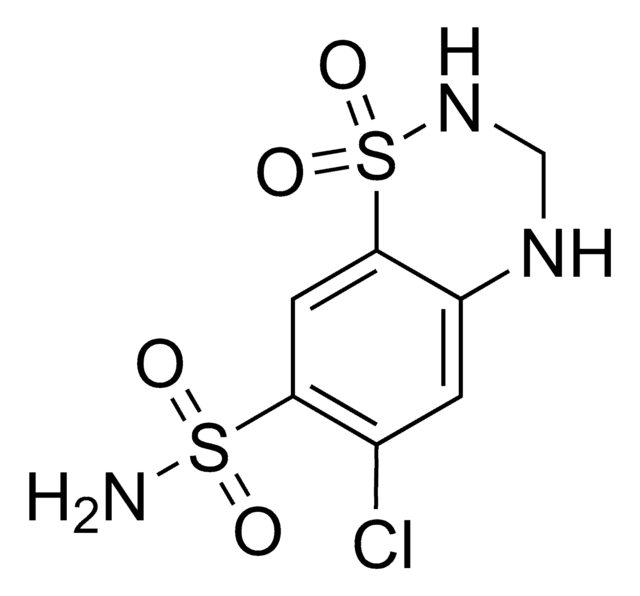C-053
Carbamazepine solution
1.0 mg/mL in methanol, ampule of 1 mL, certified reference material, Cerilliant®
About This Item
Recommended Products
grade
certified reference material
form
liquid
feature
SNAP-N-SPIKE®, SNAP-N-SHOOT®
packaging
ampule of 1 mL
manufacturer/tradename
Cerilliant®
concentration
1.0 mg/mL in methanol
technique(s)
gas chromatography (GC): suitable
liquid chromatography (LC): suitable
application(s)
clinical testing
format
single component solution
storage temp.
−20°C
SMILES string
O=C(N)N1C2=C(C=CC=C2)C=CC3=C1C=CC=C3
InChI
1S/C15H12N2O/c16-15(18)17-13-7-3-1-5-11(13)9-10-12-6-2-4-8-14(12)17/h1-10H,(H2,16,18)
InChI key
FFGPTBGBLSHEPO-UHFFFAOYSA-N
Gene Information
human ... SCN10A(6336) , SCN11A(11280) , SCN1A(6323) , SCN2A(6326) , SCN3A(6328) , SCN4A(6329) , SCN5A(6331) , SCN7A(6332) , SCN8A(6334) , SCN9A(6335)
General description
Application
- Carbamazepine research solution: A study focuses on the development of cobalt-nitrogen co-doped carbon nanotubes for the activated peroxymonosulfate degradation of Carbamazepine, highlighting its applications in environmental cleanup and pollution control (Molecules, 2024; doi: 10.3390/molecules29071525).
- Anticonvulsant biochemical reagent: Carbamazepine is utilized in research involving the production and characterization of activated carbon for removing pharmaceutical pollutants from various water sources, demonstrating its relevance in sustainable water treatment technologies. (Materials, Basel).
- Neuroscience research chemicals: Investigations into novel composite materials for the removal of pharmaceuticals from water matrices include Carbamazepine as a target contaminant, emphasizing its importance in studies related to environmental health and safety (Environ Res, et.al).
- Ion channel inhibitor: Research into new materials for drug residue removal includes Carbamazepine, showcasing its utility in evaluating the performance of innovative water treatment solutions (Carbohydr Polym, 2024).
- Epilepsy pharmacological studies: A study involving the LED-driven photo-Fenton process for micropollutant removal highlights the application of Carbamazepine in assessing the efficacy of advanced oxidative processes for environmental decontamination (J Environ Manage, 2024).
Legal Information
related product
Signal Word
Danger
Hazard Statements
Precautionary Statements
Hazard Classifications
Acute Tox. 3 Dermal - Acute Tox. 3 Inhalation - Acute Tox. 3 Oral - Flam. Liq. 2 - Skin Sens. 1 - STOT SE 1
Target Organs
Eyes
Storage Class Code
3 - Flammable liquids
WGK
WGK 1
Flash Point(F)
49.5 °F - closed cup
Flash Point(C)
9.7 °C - closed cup
Certificates of Analysis (COA)
Search for Certificates of Analysis (COA) by entering the products Lot/Batch Number. Lot and Batch Numbers can be found on a product’s label following the words ‘Lot’ or ‘Batch’.
Already Own This Product?
Find documentation for the products that you have recently purchased in the Document Library.
Customers Also Viewed
Articles
The application note describes a comparative analysis of plasma protein binding results for free/bound drugs using two different sample extraction steps, with and without agitation.
The application note describes a comparative analysis of plasma protein binding results for free/bound drugs using two different sample extraction steps, with and without agitation.
The application note describes a comparative analysis of plasma protein binding results for free/bound drugs using two different sample extraction steps, with and without agitation.
The application note describes a comparative analysis of plasma protein binding results for free/bound drugs using two different sample extraction steps, with and without agitation.
Our team of scientists has experience in all areas of research including Life Science, Material Science, Chemical Synthesis, Chromatography, Analytical and many others.
Contact Technical Service















